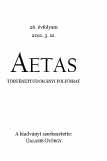Etil, a kazárok városa (Az urbanizáció kezdetei Volga-vidéken a középkorban)
The City of the Khazars: Etil. The Beginnings of Urbanization in the Lower Volga Region
Author(s): Szabolcs PolgárSubject(s): History
Published by: AETAS Könyv- és Lapkiadó Egyesület
Summary/Abstract: One of the important topics in the history of the Khazars is the localization, origin and role of their „capital”, Etil (Atil). New archaeological findings in the region of the modern town of Astrakhan may be connected to the former Khazar settlement. The paper aims to summarize the information from the written sources on Etil. It consists of three parts: 1. The problem of the localization and structure of Etil: Where was Etil? Was Etil a real town? Did it have urban structure? 2. The foundation of Etil. When and how was Etil established? 3. The role Etil played in the history of Eastern Europe and other medieval towns in the lower Volga region. We cannot localize Etil for certain. According to the written sources, it was located in the delta of the Volga river, but more precise localization would require archaeological data. Etil was a town, which consisted of two or three parts on the right and left banks of the river and on an island. Contemporary Muslim authors mentioned Etil as a „town”, it had a royal palace, markets, mosques and public baths. The royal palace (fortress) was built brick building, while the city houses were made of wood. There were tents as well in the city. It seems that Etil was similar to the towns of Central Asia but it had a special character (the tents and maybe the imperfection of the street-system). The origin of Etil is questionable. Tradition has it that the foundation of Etil was connected to the Arab threat. The original Khazar centers, situated in the Northern Caucasian region, as well as the Khazar royal court were moved north, near the Volga river. The terminus post quem of the migration could be the period between 722 and 737 A. D. But there is an alternative view, which claims that the founding of Etil was not related to the Arab threat but it was rather driven by the trading boom of the second half of the eight century. The lower Volga region was located in the intersection of the most important trade routes in Eastern Europe: the „Fur road”, that is the Volga route connected the northern regions with the Caspian sea, and the Northern, Central Asian part of the Silk road, which connected Central Asia with the Byzantine empire. According to this theory, the terminus post quem should be a later date in the last quarter of the eight century. Etil had an important role in many different ways: it was a political center. The Khazar empire was the strongest political power in Eastern Europe in the eight-ninth centuries and in the first half of the tenth century. Then the political center was in the steppe region. Later, in the eleventh-thirteenth centuries there existed three political centers (the nomads of the steppe: Pechenegs, Cumans), the Volga Bulgaria and the Rus. In this period, there was a balance of power.
Journal: AETAS - Történettudományi folyóirat
- Issue Year: 2011
- Issue No: 3
- Page Range: 50-67
- Page Count: 18
- Language: Hungarian

